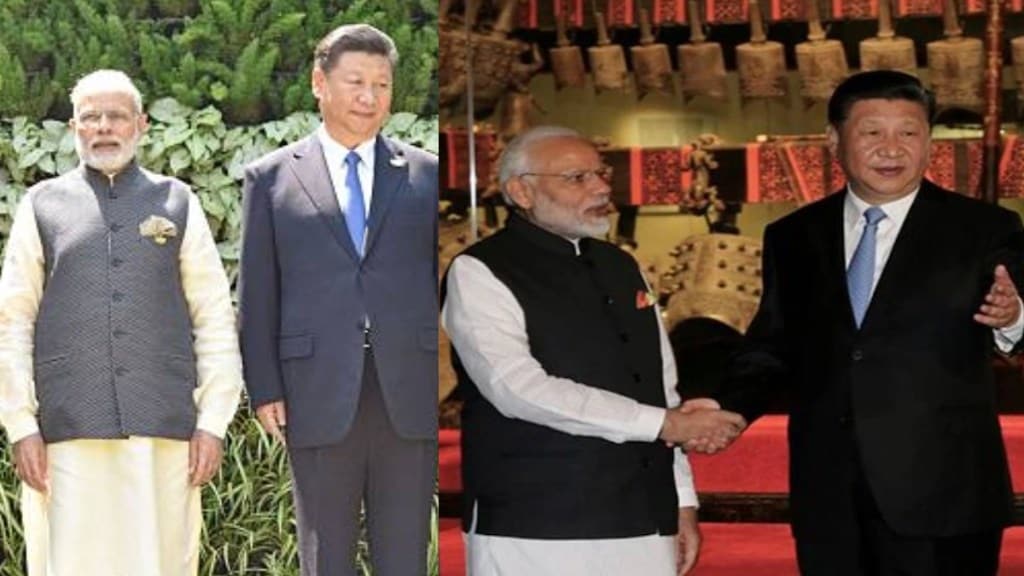Prime Minister Narendra Modi and Chinese President Xi Jinping held a crucial bilateral meeting on the sidelines of the BRICS Summit in Kazan, Russia, on October 23, 2024. This marked their first structured conversation in five years, following a significant agreement between India and China to resume regular patrolling along the Line of Actual Control (LAC) in eastern Ladakh. This development comes after years of strained relations following the 2020 Galwan Valley clashes.
Key Discussions: Border Patrolling and Bilateral Stability
Modi welcomed the recent agreement between India and China on patrolling arrangements, underscoring its importance for peace and stability along the contested border. He stressed that “maintaining peace and stability on the border should remain our priority.” He also noted that mutual trust, respect, and sensitivity are essential to maintaining cordial relations between the two neighbouring powers.
The two leaders agreed that special representatives from both countries would meet soon to further manage peace and tranquillity in the border regions. The Prime Minister highlighted that their efforts would focus on resolving disputes that have lingered since the 2020 standoff. The dialogue will also involve regular meetings between Foreign Ministers and other senior officials to rebuild bilateral ties, emphasizing a fair and acceptable resolution to the boundary question.
At a special briefing following the talks between the leaders, foreign secretary Vikram Misri described the patrolling agreement as the culmination of “extensive discussions over the past several weeks with Chinese interlocutors at both diplomatic and military levels.” China’s Foreign Ministry spokesperson Lin Jian also echoed this sentiment, stating, “We have reached a resolution on the relevant matter, and we will work with the Indian side to implement it.”
Focus on Strategic Stability and Cooperation
During the talks, both leaders acknowledged the importance of maintaining stable and predictable bilateral relations, which they believe will contribute positively to regional and global peace. Modi and Xi stressed the need to view their relationship from a “strategic and long-term perspective,” enhancing communication between their countries. The Indian Prime Minister noted that “mutual trust and sensitivity” should guide India-China relations, emphasizing the significance of peaceful border management in advancing cooperation.
President Xi, for his part, called for strengthened communication and cooperation, particularly in their roles as major developing nations and influential members of the Global South. Xi emphasized that India and China should “properly handle our differences and disagreements” while also pursuing their respective development goals. He pointed out that the bilateral relationship is vital not only for the two countries but also for global stability and prosperity.
“We must shoulder our international responsibilities and set an example for the Global South,” Xi said, highlighting the importance of promoting multipolarity and democratization in international relations.
The 2020 Standoff: A Turning Point
The India-China border standoff that began in eastern Ladakh in 2020 severely impacted bilateral relations, with both countries deploying thousands of troops along the LAC. Tensions reached a peak during the violent Galwan Valley clashes, which resulted in casualties on both sides. Despite multiple rounds of military and diplomatic talks, disengagement had been slow, leaving areas like Depsang and Demchok unresolved.
The recent agreement on patrolling arrangements, which was finalized after 17 rounds of diplomatic discussions and 21 rounds of military dialogue, represents a significant de-escalation in the conflict. With the resumption of patrolling in critical areas like Depsang and Demchok, the agreement also signals India’s ability to return to its pre-standoff patrolling stations. The settlement of disputes in Gogra-Hot Springs, Pangong Lake, and Galwan Valley further demonstrates the progress both nations have made toward maintaining peace in the region.
BRICS Summit: A Platform for Dialogue
Prior to their bilateral meeting, Modi and Xi participated in the BRICS Summit’s closed plenary session, where they shared their perspectives on global governance reforms and the role of BRICS in addressing key global challenges. Modi emphasized a “people-centric approach” to problem-solving and reiterated the importance of reforming multilateral institutions to reflect the concerns of the Global South.
Highlighting the work of the BRICS group in fostering economic growth, Modi spoke about initiatives aimed at trade facilitation in agriculture, resilient supply chains, and e-commerce. He also announced that India’s BRICS Startup Forum, which will launch this year, will add significant value to the group’s economic agenda. Meanwhile, Xi Jinping focused on promoting sustainable development, calling for BRICS countries to collaborate on green industries, clean energy, and green mining to advance a green industrial chain.
A Positive Step Forward
The talks between Modi and Xi are a pivotal moment for India-China relations, marking the beginning of a new phase of cooperation. While significant challenges remain, especially in resolving long-standing border disputes, the dialogue signals a mutual willingness to restore stability and strengthen bilateral ties.

